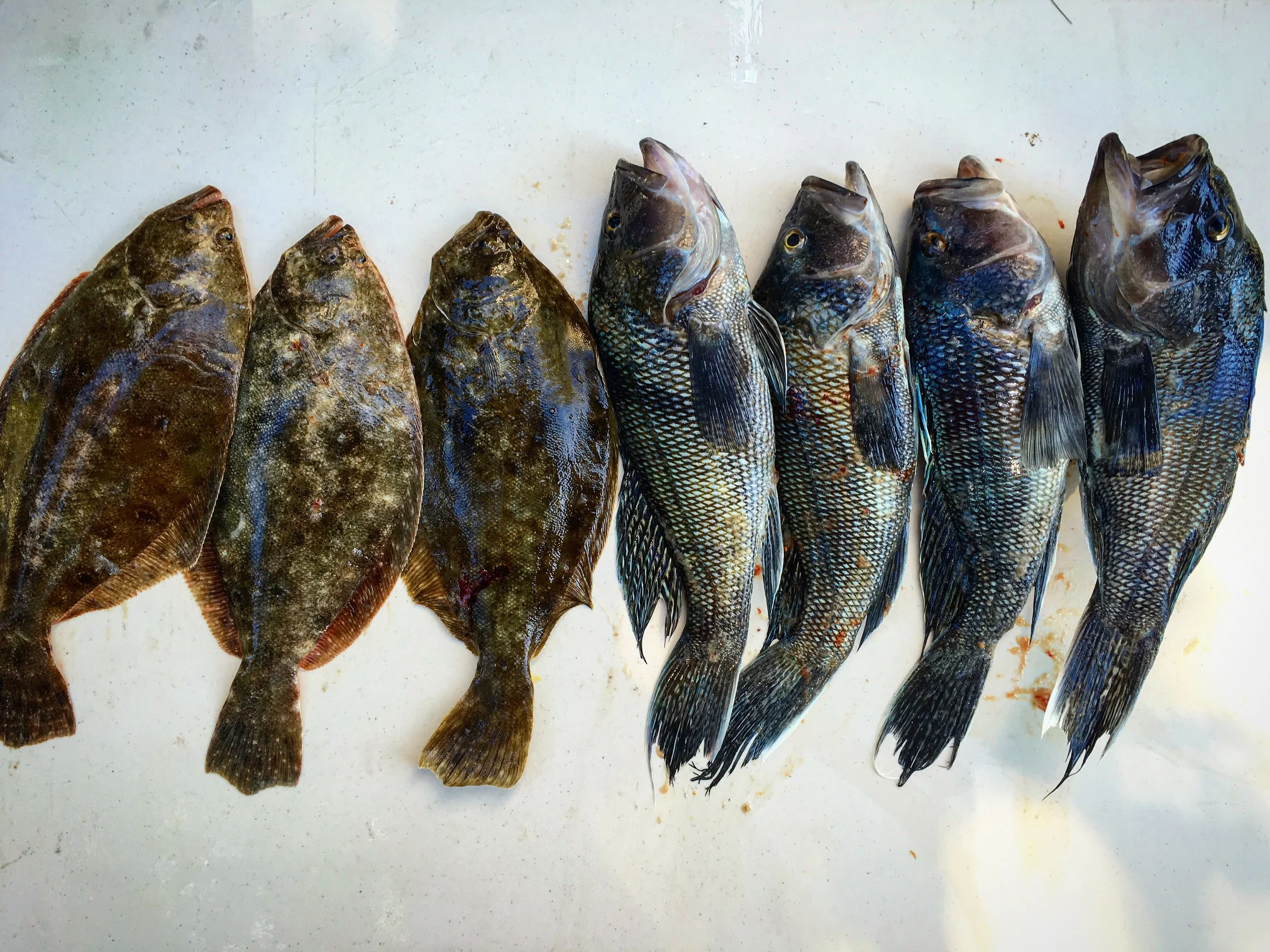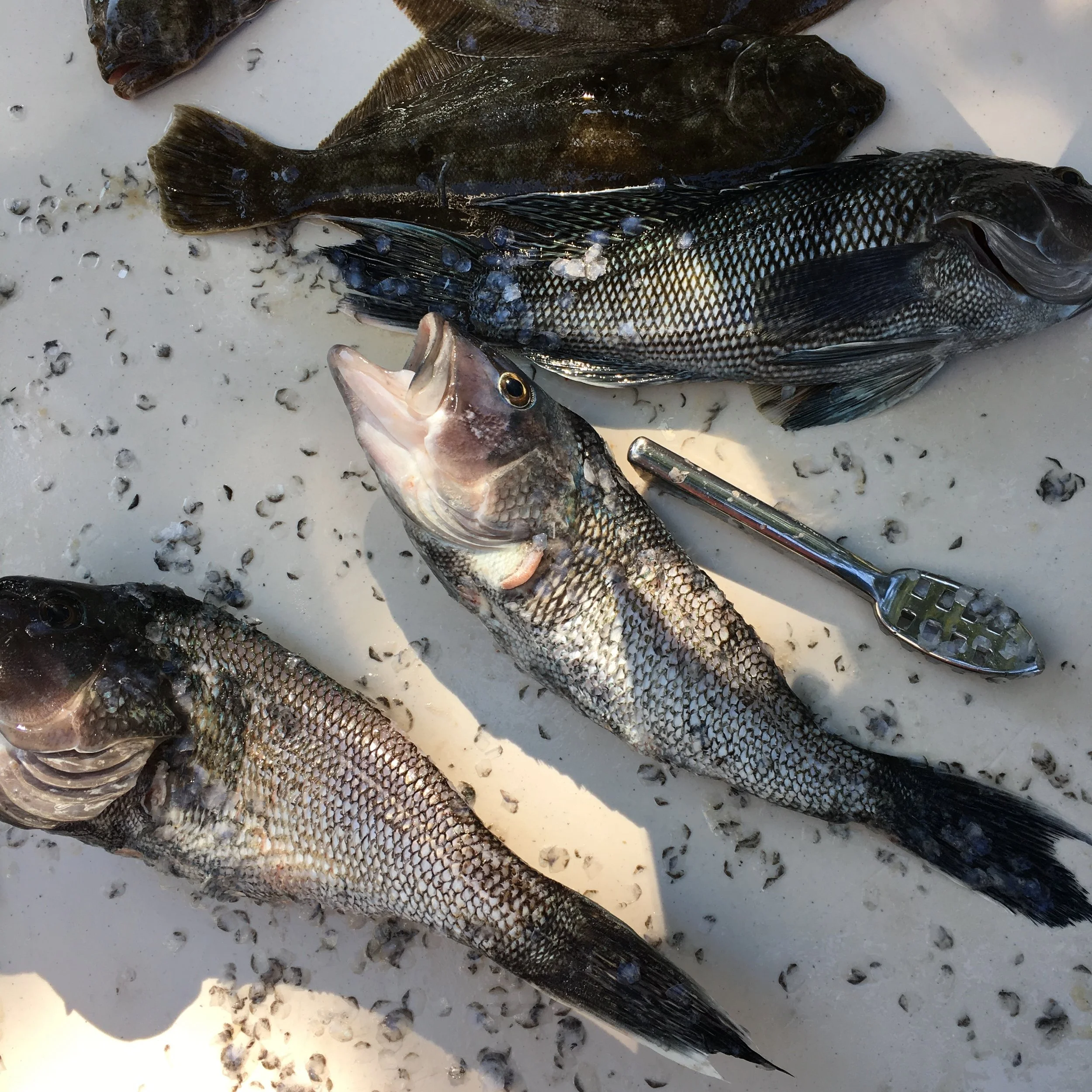Reeling in Stripers
Is This Feisty Fish the Poster Child of a Comeback Fishery or on the Brink of Yet Another Collapse?
by Clare Leschin-Hoar
Boston cast its net as a seafood town centuries ago. Today, visitors and locals alike still beeline it for steamed lobster, fried clams and fish centered dinners. But for eaters aware of the very real sustainability issues surrounding much of the fish that lands on our dinner plates, finding a seafood meal they can feel good about can be a tricky process.
Come July and August, many turn to restaurants whose menus showcase an abundance of meaty, delicious striped bass, and for good reason. Striped bass is local, sustainable and, for the most part, still wild-caught. Those traits once were shared by other local fish such as bluefin tuna, Atlantic halibut, skate and our city's beloved icon: cod.
Harvested by commercial fishermen using hook and line method only (no trawlers here), and given a coveted green rating by environmental groups like Seafood Watch, it would be easy to assume that striped bass was a hands-down winner, right?
But as with many issues surrounding fish, the answer depends on whom you ask.
Striped bass is either the poster child of a fishery recovered from its near collapse in the early 1980s, or it's once again showing ominous signs of diminishing numbers. And like many topics that touch on shared natural resources, this feisty fish has the ability to ignite passionate debate among those who spend their summer months chasing it off our shorelines.
"I remember when you couldn't buy a striped bass," says State Representative Matthew Patrick of Falmouth. "You couldn't find one or catch one in the 1980s, and I'm afraid that could happen again. That would be a blow we just couldn't sustain."
The lawmaker sees the fish in both an environmental light and an economic one. He sponsored a bill that would half the number of stripers recreational fisherman could take from two to one fish per day, and proposed eliminating the commercial catch entirely. The bill, debated in January, was sent to committee and is not expected to pass.
Patrick argued that allowing only recreational fishing of striped bass (similar to Maine, New Hampshire, Connecticut, New Jersey and Pennsylvania) would generate important economic activity for area restaurants, hotels, bait-and-tackle shops and overall tourism. This view is supported by Stripers Forever, a vocal lobbying group of recreational fishermen.
"I love catching them, and I haven't been able to catch a keeper since 2007," says Patrick.
By the Numbers
Whether that's a testament to Patrick's fishing skills or not, we're not sure, but his concern that stocks of striped bass are declining is supported by the Atlantic StatesMarine Fisheries Commission (ASMFC) and by the Massachusetts Division of Marine Fisheries, which monitor the fishery.
According to an ASMFC report, landings from Maine to North Carolina declined in 2007 and 2008 because of a decreased abundance, which is defined as the total number of striped bass estimated in the population. In plain English, that means there are fewer young fish migrating up from the Chesapeake Bay area to our coastal waters.
But officials say it's too early to ring alarm bells. Stocks are still far above threshold levels that would trigger action to protect the fishery. Estimates put the population of mature female striped bass at 55,500 metric tons, well above the threshold 30,000-ton level that would begin management plans.
The next full assessment of wild stocks is scheduled for 2012, but officials say they're monitoring the fishery constantly, including a separate survey for juveniles.
So why the decline in numbers? Scientists say there are a number of reasons. Some point to natural fluctuations in the number of young being born; issues of pollution in the Chesapeake Bay area (where 80 percent of our stocks migrate from); heavy rainfall that flooded breeding grounds; poaching of striped bass in the 3- to 200-mile offshore areas where fishing for stripers is not allowed; and mycobacteriosis, a potentially deadly disease plaguing young striped bass in the Chesapeake Bay.
Patrick says there's a level of mistrust adding to the issue.
"The Department of Marine Fisheries are the same people who were regulating the fish when it crashed in the 1970s. They didn't do anything to regulate it then. They didn't put a moratorium; instead it took a Federal moratorium to save the fish. I look at their data, and what I see is the spawning stock, the females old enough to lay eggs, those number are going down for the last three or four years," says Patrick.
Harwich-based Chris Caldwell, a member of Stripers Forever, advocated for Rep. Patrick's bill, and agrees the stripers are heading for trouble.
"If you make striped bass a recreational industry, then it's managed for that industry, which means more fish in the water. If you manage it for commercial fishermen, then it's managed for taking more fish out of the water," says Caldwell.
But Darren Saletta, a commercial fisherman based in Chatham, says it's not a unified commercial fishing versus recreational fishing battle. Recreational groups like the Massachusetts Striped Bass Organization also opposed the bill, he says.
"I feel like it's an attack on a very successfully managed program at a time when we need an increase protein supply globally," says Saletta.
Like many commercial fishermen, Saletta earns only a portion of his income from striped bass. He also lobsters and shellfishes, and estimates his seasonal striped bass catch makes up 38 percent of his income.
With the exception of Rhode Island, Massachusetts is the only New England state with a commercial fishery. Estimates put the state's recreational catch near 5.5 million pounds, dwarfing the commercial catch, which is approximately 1.1 million pounds of striped bass.
"To lose my bass income would simply be devastating and quite possibly the last straw. It was a significant portion of my income last year. If I lose that income, I may become part of what the Cape Cod Times has deemed ‘Generation Exit,' the 20- to 30-year-olds that cannot afford to live on cape anymore and are being forced to move," he says.
Saletta says fewer landings of striped bass doesn't automatically mean there are fewer fish in the water. Other factors are harder to measure, he says. A weaker economy meant fewer fishermen were filling gas tanks to go fishing. He also points to the boom in the grey seal and harbor seal populations, which feed on striped bass; and suggests an increase in inshore water temperatures may mean striped bass have retreated to cooler water.
Michael Armstrong, assistant director for the Massachusetts Division of Marine Fisheries, agrees the numbers are lower, and says the current decline has nothing to do with poor fisheries management.
"Right now we have the same spawning stock biomass. The weight of females putting eggs in the water is the same as 10 years ago," says Armstrong. "But what we're getting is bad survival, driven by what's going on in the Chesapeake Bay. If things continue to decline, we'll ratchet back on commercial and recreational fishing to preserve biomass, but we're nowhere near that point yet."
Health Considerations
Among stripers, the females grow largest. Size limits for recreational catch are set at a 28-inch minimum, while commercial fishermen are only allowed to take 34-inches and above. Critics of the commercial fishery say that because of this size limit, commercial fishermen are targeting females that have the ability to lay the highest number of eggs. Others say that by the time the fish reaches 34 inches in size, those females have survived several spawning seasons, and therefore the size limit protects the fishery.
The larger fish also have environmentalists warning of another cause for concern: PCB intake.
"PCBs are more of an issue with striped bass than mercury," says Tim Fitzgerald of the Environmental Defense Fund (EDF). "And a 40-pound striped bass is likely to be loaded. While the fishery is responsibly managed it's unfortunately fairly contaminated."
Fitzgerald says children and women aged 18-45 should not eat striped bass in great quantities, and recommends having it less than once a month. PCBs are considered a probable carcinogen, and can accumulate in a person's body over time.
"One meal is not going to harm you, but repeated consumption-weekly or even monthly-leads to a higher level of health risks. We're not talking about poisoning, but exposure over an extended period of time should be avoided if at all possible," says Fitzgerald.
The size of the fish, how often it's consumed, the portion size and the size of the eater all play a role in determining risk. And, unless you catch the fish yourself, it's difficult to know if the filet at a restaurant or fish counter was taken from a fish that weighed in at over 40 pounds.
Chef Jeremy Sewall of Lineage in Brookline and Eastern Standard Kitchen in Boston says with less availability of cod and haddock over the years, chefs have had to look towards other white-fleshed fish to fill in. Striped bass has emerged as the go-to choice for chefs seeking a seasonal, sustainable fish to offer their customers.
As for the contamination issues, Sewall says moderation is the key. "I don't eat striped bass every day, but I feel good about serving it from a health and sustainability standpoint. For example, it has far less mercury than marlin, swordfish or tuna," he says.
Sel de la Terre's Chef Louis DiBiccari holds plenty of childhood memories of fishing. Growing up in Lynnfield, he'd often head out with his step-grandfather for a day of fishing on the water. They'd pull up cod or haddock and "always flounder," he says. "Always."
"But once I got in the field, I fell in love with striped bass when I realized you could do so many preparations with it. It's a versatile fish, and goes beautifully with everything from spring asparagus and fava beans to late-summer tomatoes, or ingredients like chorizo and clams," he says.
Simon Kershaw, chef at VeeVee in Jamaica Plain, a recent transplant from Ireland, says he sees striped bass emerging as the new signature fish of New England.
"Striped bass has that quality where it's user friendly. It's easy to cook, keeps its moisture and juiciness, and it has that meaty quality," he says. "I hadn't seen it before I got here, and was amazed it was such a beautiful fish."
But is it accepted enough to elbow out old time (but dwindling) favorites like cod?
"I don't know that you're ever going to replace cod in the Boston summertime market. It's a tough fish to beat. A lot of old Yankees here gravitate to what they know and feel safe with. But the old Yankee kids grow up, and they're seeing chefs do a great job with striped bass, so maybe it's now fin-to-fin" says DiBiccari.
Recipes
Clare Leschin-Hoar's has a few fish stories of her own. You can readmore at her website: www.leschin-hoar.com.
This story appeared in the Summer 2010 issue.



